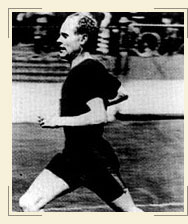|
 Paavo
Nurmi
Paavo
Nurmi
Paavo Nurmi is one of the athletes-legends in the history of the Olympic Games. With twelve medals, nine golds and three silvers, in three  consecutive Olympic organizations (1920, 1924, 1928) and tens of world and Olympic records, he was the preeminent figure among the so-called "flying" Finns, who had prevailed in middle-distance and long-distance running for more that a decade and had challenged the predominance of the American athletes in track and field events. consecutive Olympic organizations (1920, 1924, 1928) and tens of world and Olympic records, he was the preeminent figure among the so-called "flying" Finns, who had prevailed in middle-distance and long-distance running for more that a decade and had challenged the predominance of the American athletes in track and field events.
He was born on 13 June 1897 in the city of Turku, Finland. He was the oldest son of a poor four-member family. His father, who came from a family of tenant farmers and was a carpenter, died in 1910. As a result, Nurmi, at the age of 13, quitted school and worked as assistant baker and later as warehouse keeper thus contributing to the family income, which depended on the underpaid work of his mother (she was a charwoman). In 1914, during his adolescence, he decided to take up athletics and became a member of the local sports association in Turku, a common activity for middle and upper social classes, but not for people of his social profile.
Until 1919-1920, when he did his military service in a politically turbulent period for Finland (1917: independence from Russia, 1918: civil war), Nurmi was just a mediocre athlete displaying great persistence in systematic training. The period during which he served in the army was for him the beginning of his brilliant athletic career, since it coincided with even more systematic training and the first good performances. A month before the Games of Antwerp (1920) he broke the national record in several long-distance events, thus securing his first participation in the Olympic Games.
In Antwerp he had won three gold medals, in the 10,000m and 8,000m cross-country (individual and team), under the guidance of Hannes Kolehmainen. Before that, he had finished in the second place in the 5,000m. However, Nurmi's great moment came four years later, in the eighth Olympic Games held in Paris: five gold medals (1500m, 5,000m, 10,000m individual and team cross-country and 3,000m team). His most spectacular performance occurred on 10 July, when in less than an hour, after having won the 1500m, he participated in the 5,000m and won the gold medal. He could have won yet another medal in the 10,000m, if the heads of the Finnish team had not preferred to "sacrifice" Nurmi for another great athlete, Ville Ritola. His next participation in the 1928 Olympic Games was his third and last. He won a gold medal in the 10,000m and two silvers in the 5,000m and in the 3,000m steeplechase.
Nurmi planned to end his athletic career with a victory in an Olympic marathon, after the example of Hannes Kolehmainen. However, a few days before the Games of 1932 his participation was rejected with the accusation of professionalism. Soon after that he ended his athletic career.
He then became trainer of the Finnish team for the Olympic Games of 1936. Soon, however, his professional activities took a different direction. He set up a large construction company, the activities of which afforded him considerable gains. Together with Kolehmainen he was the guest of honour in the Olympic Games held in Helsinki in 1952. He died on 2 October 1973 in Helsinki.
|